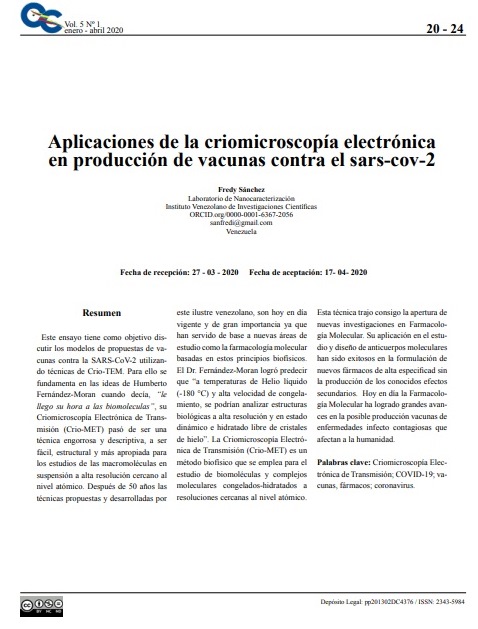Applications of Electronic Cryomicroscopy in Production of Vaccines against SARS-CoV-2
Keywords:
Cryo-Electron Microscopy; COVID-19; vaccines; drugs; coronavirusesAbstract
This essay aims to discuss models of SARS-CoV-2 vaccine proposals using Cryo-TEM techniques. It is based on ideas Humberto Fernández Morán;when he said, “time has come for biomolecules”, his Electronic Cryomicroscopy Transmission, (Cryo-TEM), went from being a cumbersome and descriptive technique to being easy, structural and more appropriate for studies of macromolecules in high resolution suspension close to atomic level. After 50 years the techniques proposed and developed by this illustrious Venezuelan, are today validand of great importance since they have served as a basis for new areas of study, such as molecular pharmacology based on these biophysical principles. Dr. Fernandez Moran managed to predict that “at liquid Helium temperatures (-180 ° C) and high freezing speed, biological structures could be analyzed at high resolution and in a dynamic and hydrated state free of ice crystals.” Electronic Cryomicroscopy Transmission, (CryoTEM) is a biophysical method that is used to study biomolecules and frozen-hydrated molecular complexes at resolutions close to the atomic level. This technique brought with it the opening of new research in Molecular Pharmacology. Its application in the study and design of molecular antibodies has been successful in the formulation of new high-specific drugs without the production of the known side effects. Today, molecular pharmacology has made great progress in the possible production of vaccines in infectious contagious diseases that affect humanity.
Downloads
References
Barrantes, F. J. (2020). While We Wait for a Vaccine Against SARS-CoV-2, Why Not Think About Available Drugs. Recuperado en, doi: 10.20944/preprints202004. 0087.v1
Benjin, X. y Ling, L. (2019). Developments, applications and prospects of cryoelectron microscopy. Protein Science. Recuperado en: doi.org/10.1002/pro.3805
Devaux , C. A.; Rolain, J. M.;Colson, P. y Raoult, D. (2020). New insights on the antiviral effects of chloroquine against coronavirus: what to expect for COVID-19. Recuperado en: https://www.sciencedirect.com/science/article/pii/ S0924857920300881
Dong, L.;Hu, S. y Gao, J. (2020). Discovering drugs to treat coronavirus disease. (2019) (COVID-19). Drug discoveries & therapeutics, 14(1), 58-60.
Graham, B. S.; Gilman, M.S. y McLellan, J. S. (2019). Structure-Based vaccine antigen design. Annual review of medicine, 70, 91-104.
Kolifarhood, G.; Aghaali, M.; Saadati, H. M.; Taherpour, N.; Rahimi, S.; Izadi, N. y Kumar, S. (2020). Drug and vaccine design against Novel Coronavirus (2019-nCoV) spike protein through Computational approach. Recuperado en , doi: 10.20944/preprints202002. 0071.v1
López E. (2020). Coronavirus: la infección que apenas conocemos. Revista de Divulgación Científica “Los Ojos de la Ciencia” Instituto Nacional de Higiene “Rafael Rangel”,1(3) 16-30.
Lu, H. (2020). Drug treatment options for the 2019-new coronavirus (2019-nCoV). Bioscience trends, 14(1), 69-71.
Ouyang, S. (2020). Cryo-electron microscopy structure of the SADS-CoV spike glycoprotein provides insights into an evolution of unique coronavirus spike proteins. Recuperado en: doi.org/10.1101/2020.03.04.976258
Wan, Y.; Shang, J.; Sun, S.; Tai, W.; Chen, J.; Geng, Q. y Zhou, Y. (2020). Molecular mechanism for antibody-dependent enhancement of coronavirus entry. Journal of virology, 94(5). Disponible en : doi: 10.1128/JVI.02015-19
Wang, M.; Cao, R.; Zhang, L.; Yang, X.; Liu, J.; Xu, M.y Xiao, G. (2020). Remdesivir and chloroquine effectively inhibit the recently emerged novel coronavirus (2019-nCoV) in vitro. Cell research, 30(3), 269-271.
Wrapp, D.;Wang, N.; Corbett, K. S.; Goldsmith, J. A.; Hsieh, C. L.;y McLellan, J. S. (2020). Cryo-EM structure of the 2019-nCoV spike in the prefusion conformation. Science, 367(6483), 1260-1263

Downloads
Published
How to Cite
Issue
Section
License

This work is licensed under a Creative Commons Attribution-NoDerivatives 4.0 International License.







